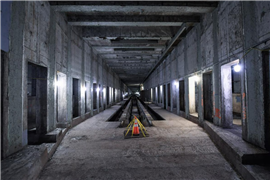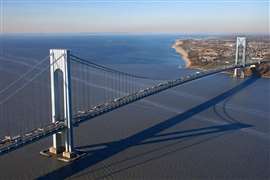3 New York City transit projects with an uncertain future after funding yanked
28 June 2024
 A subway tunnel between 110th and 120th streets, part of construction works on the Second Avenue Subway (Image: Marc A. Hermann / MTA)
A subway tunnel between 110th and 120th streets, part of construction works on the Second Avenue Subway (Image: Marc A. Hermann / MTA)
The New York City (NYC) Metropolitan Transportation Authority (MTA) met on 26 June to discuss the organisation’s budget shortfall after New York State backed-off its approval of a congestion toll programme.
The program had been expected to raise around US$15 billion over five years for the city’s transit system, but plans for the scheme have been put on hold by New York Governor Kathy Hochul. After Hochul yanked the programme, its proponents have questioned how funding for New York transportation construction projects could be affected.
The NYC congestion pricing plan – which would have been the first of its kind in the country – sought to impose a $15 toll on daytime automobile commuters entering Manhattan Borough south of 60th Street (which runs nearly parallel to the south edge of Central Park). The region is NYC’s most-densely populated including the city’s Downtown and Midtown neighbourhoods. The money raised from tolls was to help future MTA construction projects.
According to MTA deputy chief development officer Tim Mulligan, speaking at last week’s meeting, the move to pause the implementation of congestion pricing in New York City has caused a $16.5 billion hole in the MTA’s funding through its current five-year plan (which ends this year) and has cast fresh doubts on the next five-year plan that will run from 2025 to 2029.
“The net impact is $16.5 billion,” confirmed Mulligan during a presentation on how the MTA can maintain its operation with its current state of funding. He noted that the organisation has just $12 billion in available funds for $27-billion-worth of committed projects.
Mulligan said the group will find ways to reprioritise and shift funds to highest-need projects, but he also went through several schemes that are likely to be deferred and potentially cancelled altogether.
1) Second Avenue Subway Project Phase II is deferred
Mulligan confirmed at the 26 June MTA board meeting that the second leg of a multi-billion-dollar upgrade and expansion project for the Second Avenue subway is deferred. Construction was underway but was paused after the state’s rejection of the congestion pricing programme.
 The intersection of Second Avenue and East 42nd Street in New York City, New York, US. (Image: Adobe Stock)
The intersection of Second Avenue and East 42nd Street in New York City, New York, US. (Image: Adobe Stock)
The phase is estimated to cost between $5 billion and $8 billion, with local entities committing $3 billion and federal agencies contributing $2 billion as of this month. Overall, the multi-phased project was projected to cost more than $17 billion and construction to last at least one decade.
In order to keep funding for “state-of-good-repair” projects and general maintenance, Mulligan said local funds will need to move elsewhere, and the federal gift may be lost, at least in the short-term.
“We are sacrificing the immediate use of the $2 billion, because we need that $3 billion that would have gone to the local contribution to mitigate the state-of-good-repair loss of available funds,” said Mulligan.
Development and work on phase two – which includes tunnel boring, new rail, and upgraded stations – started in 2017. Joint venture Parsons-Brinckerhoff and STV won the design contract, and initial construction bids went out in 2023. New York-based C.A.C. Industries won an initial $182 million contract for phase two in January 2024.
Construction on phase two was scheduled to last through 2032.
2) Hollis and Forest Hills station upgrades cancelled
 Forest Hills Station in New York City. (Image: Adobe Stock)
Forest Hills Station in New York City. (Image: Adobe Stock)
In total, Mulligan said 23 subway station accessibility projects would be deferred, and he added that two of the larger projects – at Hollis and Forest Hills stations on the LIRR (Long Island Rail Road) – are no longer under consideration.
“[The MTA] announced a stop order,” said Mulligan, noting only the design process had been completed. “Construction has not started in earnest, and the funds that are recovered from those actions are repurposed.”
Forte Construction was listed as the contractor for the project, which also includes work at Babylon Station (which is still underway). The entire contract for updates at Babylon, Hollis, and Forest Hills was listed at $227.5 million.
3) Verrazzono-Narrows Bridge ramp reconstruction and cable dehumidification deferred
Also pushed back was work on the Verrazzono-Narrows Bridge, which was scheduled to receive a new access ramp and a main cable dehumidification system.
Two solicitations for design-build work and project management went out in April with due dates in May. A range of value was provided at more than $120 million to $150 million for both contracts combined.
 The Verrazzano-Narrows Bridge, which connects New York City boroughs Staten Island and Brooklyn. (Image: Adobe Stock)
The Verrazzano-Narrows Bridge, which connects New York City boroughs Staten Island and Brooklyn. (Image: Adobe Stock)
Some work contracts for the bridge were awarded in recent years, including just less than $10 million to EnTech Engineering, $128.5 million to Ahern Painting Contractors, $12 million to Hardesty & Hanover-LiRo JV, $7 million to Gannett Fleming Engineering & Architects, $79 million to Hellman/PJS JV, and just less than $1.5 million to Pencol Contracting.
The scope of the listed contracts ranges from painting work, resiliency improvements, and repair.
Some of the work listed, the earliest of which was awarded in 2022 to Pencol, may already be complete.
What does this mean for contractors?
This was a question MTA board members asked throughout the meeting, with several concerned the lost income would have a negative effect on New York builders.
Board member Samuel Chu said, “The downstream impact on our regional economy, on contractors, some of which are very vulnerable… I wouldn’t want to see us take a step backwards.”
Mulligan said the MTA was engaging contractors early, particularly those at risk of have stops assigned to their work, but he also noted most contracts involve contingency payments to the firms once change orders or stops are triggered.
“There is a cost to cancel a project or descoping,” he confirmed. “You have to negotiate a credit with the contractor, and you typically don’t get the full value when you’re negotiating with credit.”
Ultimately, the disappearance of billions-worth of funding for infrastructure and construction projects will have an immediate negative impact on the existing contracts, while casting doubt on the viability of any future contracts issued from the MTA as part of their budgeting plan.
MTA board member Norman Brown didn’t mince words when expressing his thoughts on the effects it would have on some builders.
“It’s not easy to find skilled people, especially in New York, these days,” he said. “Contractors that did MTA work… they have tooled up and invested in these companies, people have committed their careers… and now you’ve pulled the legs out from under them. This is one of the worst things that happened to the MTA in the long time that I’ve been here.”
STAY CONNECTED



Receive the information you need when you need it through our world-leading magazines, newsletters and daily briefings.
CONNECT WITH THE TEAM






